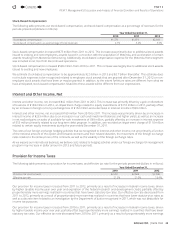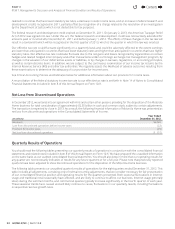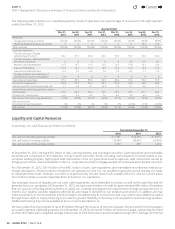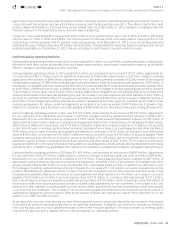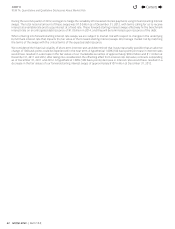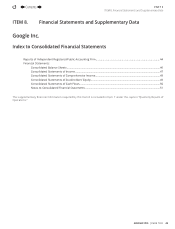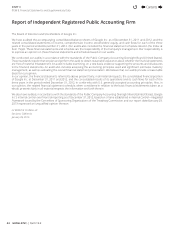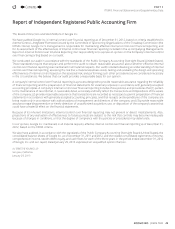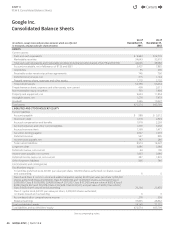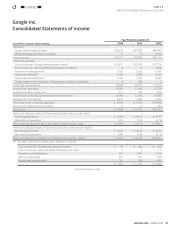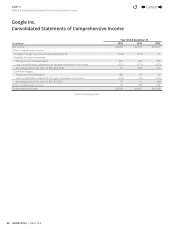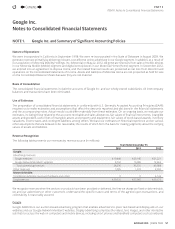Google 2012 Annual Report Download - page 47
Download and view the complete annual report
Please find page 47 of the 2012 Google annual report below. You can navigate through the pages in the report by either clicking on the pages listed below, or by using the keyword search tool below to find specific information within the annual report.
41GOOGLE INC. |Form10-K
PART II
ITEM7A.Quantitative and Qualitative Disclosures About MarketRisk
ITEM7A. Quantitative and Qualitative Disclosures About
MarketRisk
We are exposed to fi nancial market risks, including changes in currency exchange rates and interest rates.
Foreign Currency Exchange Risk
Economic Exposure
We transact business in various foreign currencies and have signifi cant international revenues, as well as costs denominated in
foreign currencies. This exposes us to the risk of fl uctuations in foreign currency exchange rates. We purchase foreign exchange
option contracts to reduce the volatility of cash fl ows related to forecasted revenues denominated in certain foreign currencies.
The objective of the foreign exchange contracts is to better ensure that the U.S. dollar-equivalent cash fl ows are not adversely
aff ected by changes in the U.S. dollar/foreign currency exchange rates. These contracts are designated as cash fl ow hedges. The
gain on the eff ective portion of a cash fl ow hedge is initially reported as a component of accumulated other comprehensive income
(AOCI) and subsequently reclassifi ed into revenues when the hedged revenues are recorded or as interest and other income,
net, if the hedged transaction becomes probable of not occurring. The notional principal of these contracts was approximately
$6.5billion and $9.5billion as of December31, 2011 and December31, 2012. These foreign exchange contracts have maturities
of 36 months or less.
We considered the historical trends in currency exchange rates and determined that it was reasonably possible that changes in
exchange rates of 20% for our foreign currencies instruments could be experienced in the near term. If the U.S. dollar weakened
by 20%, the amount recorded in AOCI before tax eff ect would have been approximately $132million and $9million lower at
December31, 2011 and December31, 2012, and the total amount of expense recorded as interest and other income, net, would
have been approximately $138million and $140million higher in the years ended December31, 2011 and December31, 2012. If
the U.S. dollar strengthened by 20%, the amount recorded in accumulated AOCI before tax eff ect would have been approximately
$1.2billion and $1.7billion higher at December31, 2011 and December31, 2012, and the total amount of expense recorded
as interest and other income, net, would have been approximately $202million and $159million higher in the years ended
December31, 2011 and December31, 2012.
Transaction Exposure
Our exposure to foreign currency transaction gains and losses is the result of certain net receivables due from our foreign
subsidiaries and customers being denominated in currencies other than the functional currency of the subsidiary, primarily the
Euro and the British pound. Our foreign subsidiaries conduct their businesses in local currency. We have entered into foreign
exchange contracts to off set the foreign exchange risk on certain monetary assets and liabilities denominated in currencies other
than the local currency of the subsidiary. The notional principal of foreign exchange contracts outstanding was $3.7billion and
$6.6billion at December31, 2011 and December31, 2012.
We considered the historical trends in currency exchange rates and determined that it was reasonably possible that adverse
changes in exchange rates of 20% for all currencies could be experienced in the near term. These changes would have resulted
in an adverse impact on income before income taxes of approximately $27million and $9million at December31, 2011 and
December31, 2012. The adverse impact at December31, 2011 and December31, 2012 is after consideration of the off setting
eff ect of approximately $503million and $731million from foreign exchange contracts in place for the months of December2011
and December2012. These reasonably possible adverse changes in exchange rates of 20% were applied to total monetary assets
and liabilities denominated in currencies other than the local currencies at the balance sheet dates to compute the adverse impact
these changes would have had on our income before income taxes in the near term.
Interest Rate Risk
We invest our excess cash primarily in U.S. government and its agency securities, money market and other funds, corporate debt
securities, mortgage-backed securities, debt instruments issued by foreign governments, municipal securities, time deposits, and
asset backed securities. By policy, we limit the amount of credit exposure to any one issuer.
Investments in both fi xed rate and fl oating rate interest earning securities carry a degree of interest rate risk. Fixed rate securities
may have their fair market value adversely impacted due to a rise in interest rates, while fl oating rate securities may produce less
income than predicted if interest rates fall. Due in part to these factors, our income from investments may decrease in the future.
However, we use certain interest rate derivative contracts to hedge interest rate risk of our fi xed income securities.
4
Contents
4




